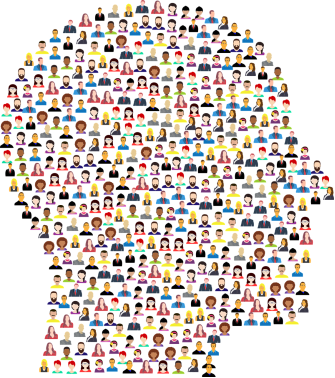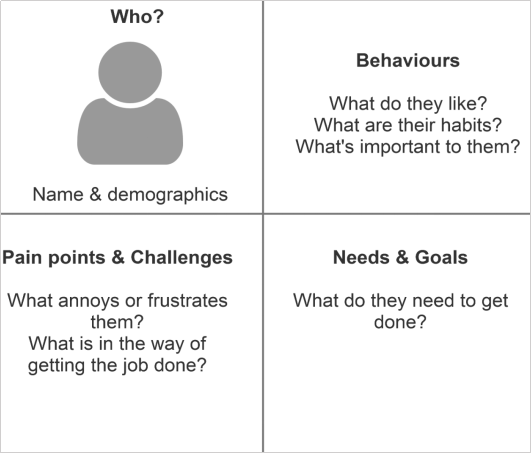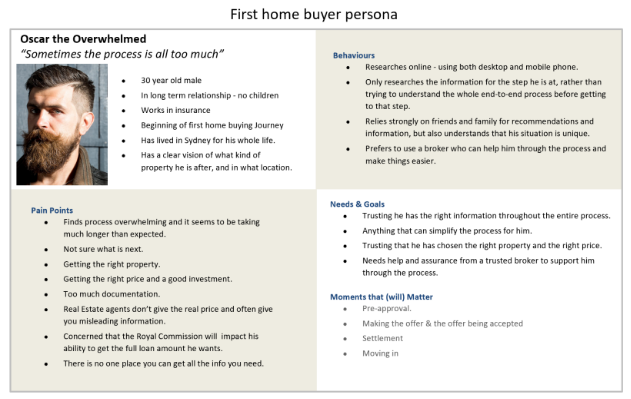When I started out in the field of UX in around the year 2000, personas didn’t really exist as part of the design process at that time. Over the years, I became aware of personas as a concept, but I never really embraced them as a useful process until very recently. I now realize how effective and useful they are, particularly for humanizing our research efforts when engaging with business stakeholders.
In this guide, we will cover everything you need to know about why, how and when to create and use personas during the UX design process. This is aimed at those who are new to UX design, and those who may be more experienced, but have not engaged in the process of creating personas.
A UX design persona is a fictitious person that is created to represent a target audience or group. While personas are often created to represent a specific target audience, they can also be used to provide insight into the motivations of existing users or customers.
The characteristics of a persona can be based on real customer data, such as demographic information and behavioral patterns, and are used by UX designers to develop a better understanding of the customer. Personas provide designers, developers, and product owners with a snapshot of the attitudes, behaviors, challenges, needs, and goals of a particular user type.
Personas can be used to ensure that a product or experience is designed with the user in mind, rather than making assumptions about how they should use the product or interact with the design. They can create focused conversations and provide a better understanding of the user journey.
Personas are sometimes developed directly through user interview data, and sometimes solely on target audience research, but more on this later.

Image by Gordon Johnson from Pixabay
In my experience, one of the key benefits of working with personas during the design process is the humanization of the customer not only for the designers but for the wider team. Once we had created our personas, we would print them out and stick them up on the wall where the developers worked. This was a constant reminder for them that our customers were real, and that part of their job was to help solve our customer's challenges and pain points.
More generally, UX design personas are important because they enable designers to empathize with their users and better anticipate their needs, resulting in a better user experience.
I have split these into two groups. The first two persona types focus on how the information is gathered and used to create the personas. The second two persona types focus on how the information is presented back to stakeholders.
These personas represent real users who may interact with a product or service, based on a series of user interviews that you or your team may conduct with real or potential users. The information used to create the persona is generally a mix of characteristics and behaviors from individual interview participants that you may use to form the final attributes of your persona. You may also identify patterns emerge from your interviews that can then be included as part of your persona.
If you are unable to interview any potential users or existing customers, online research may be your only option to gather information about your target audience. This may not be as accurate and personal as conducting user interviews, but if you research well you may be able to leverage existing studies that will match your defined audience. These type of personas represent the target audience for the product or service and they can be based on demographics, interests, and behaviour.
Lean personas describe how the persona information is captured and presented back to your stakeholders. Below is an example of a lean persona template, which only contains the key information components required to understand what is needed to design an effective user experience. It’s an efficient way to display the information as it is easy to read, the information is concise, and the presentation is not overwhelming. Less is more.

Persona template – source: Carrie Webster
These personas contain extensive biography, background and additional information on behaviours sourced from extensive research. I have seen examples of very detailed personas that extend over three or four pages, describing personality traits and elements that don’t necessarily add much value for the designer, or other stakeholders. In most cases, these longer description personas either don’t get read, or they are scanned once and then forgotten. My recommendation is to go for the lean persona approach.
The number of personas needed for a UX design project will depend on the size and complexity of the project. However, for more complex projects, you may need to create multiple personas to ensure that all user needs are considered. For a large project, you will need a UX tool to help you paint the broader picture of how content and organization will affect the experience.
As a general rule, you should create one persona per target audience type. For example, if your project is to design the user experience for a phone banking app, you may have determined that you have three target audiences, based on age groups. The age groups may be 18 – 30-year-olds, 31 – 50-year-olds, and 51 – 65-year-olds. For this particular project, you know the needs of a 65-year-old will be very different to the needs of an 18-year-old.
Another example would be if you were designing a fitness app. Maybe your target audience groups are based on levels of fitness, rather than age groups. Or if you were designing an ecommerce app for sports cars, then your target audience groups may be based on income.
By defining and understanding the challenges and pain point of the different audiences, you can consider exactly what functions and options you will need to include in your design to provide a solution across all target audience groups.

Source: Unsplash
Adding a photo or illustration of the user helps to bring the persona to life and can create empathy for your persona audience. I personally recommend providing a descriptive header for your persona, such as “Oscar the overwhelmed”, to tell the story more effectively to this same audience.
An effective persona should include the following:
· A photo and a tagline.
· Demographic data (age, family, job, location, situation)
· Behaviour and motivations (online behaviour, spending, habits)
· Pain Points (relating to situation or scenario)
· Needs and Goals (anything relating to outcomes for situation)
Include brief descriptions of the user's behaviour and activities. You could also include summary scenarios that provides context around the product or service amongst the descriptions.
If you were to just include information gathered from demographic research, here is an example of what it might look like:
First home buyers key target audience
· 80% of First home buyers based in Sydney are aged between 25 and 40.
· Most are in long-term relationships and may have young children.
· They want to know they are not overpaying for the property.
· Use multiple online services to search for properties.
· Likes to use brokers to simplify the process.
However, to create an engaging persona, you will need to include some fictional elements about the user to help tell a story that is aimed at evoking empathy. The description below explains how this works.
The persona example below demonstrates minimal information to provide maximum impact, but it also includes personal components to make feel like it’s a real person. All the descriptive elements displayed can be used to apply directly to the design approach, in other words, if the information included won’t impact the design outcomes, remove it.
For example, under Behaviours, Oscar says he “Only researches the information for the step he is at, rather than trying to understand the whole end-to-end process before getting to that step.”
As a designer, we can now empathise that our users have a need for a reduction in the complexity of the process. It is more efficient for Oscar to take one step at a time. This is crucial information that can be used in our design approach of breaking down the steps into simple, easy to follow actions.
Adding in an additional “Moments that (will) matter” can highlight what needs to be achieved as an outcome to delight your customers.

Source: Carrie Webster
At what stage of the UX design process do you create personas?
The best time to create personas is during the research and define phases of your design project. Because your persona outcomes are essential in providing an insight into your design approach, it makes sense to work on your personas before you start designing. The other benefit of completing personas early in the process is using them as part of the customer or user journey mapping activities you may engage in.
The following steps can be used to create UX design personas:
There may be more than one. Spend the time to research the user types and collect specific data for each audience. This can be done by gathering demographic data, such as age, gender, occupation, income, and habits. Additionally, it is important to look at user behaviour.
Talk with subject matter experts within you organization that can also provide you with key insights about the users. Don’t overlook sales, support, and marketing teams who often carry a wealth of information about customers.
The most effective way to gather accurate information about your target audience is to talk with them. Connecting with users to engage in user interviews is the best way to gather this information. You may have existing customers that you can engage with, or you may engage with an external agency that can recruit users for you.
If you are focussing on user interviews, it is recommended that you interview between three and five participants for each target audience group that has been identified.
If you have access to a wider user audience, you could also send out a survey to collect both qualitative and quantitative information. If you are unable to engage in interviews or surveys, you will need to rely solely on your own research.
An example of initial survey questions for a new banking app, might be:
· Please select your age group.
· Do you currently use a banking app?
· How often would you use it?
· How many transactions would you perform in a week?
· What would you like to see improved?
Once the data has been gathered from research, surveys and/or interviews, it should be analysed to identify common patterns and trends. This information is perfect to use in defining your personas.
Once you have gathered and analysed all the information, you can create your personas. For a lean persona, please refer the lean persona template displayed earlier. Of course, you may continue to refine your personas as you receive additional data or user feedback.
Don’t be afraid to share the personas with other team members, such as developers, and other stakeholders. This is an effective way to personalise the users to a wider team that may often forget there are real people with goals and objectives that need to be considered.
A user profile is a generic description of a type of user of a product, service, or website, normally based on real data gathered from users. It is created to provide an understanding of the user's needs, preferences, and behaviours and it will include general descriptions such as an age range, and education level. A user profile can be expanded to describe a target audience.
A persona is a fictional representation of a user. It is often used to provide a more vivid, detailed picture of the user's characteristics, goals, and motivations. While personas can be based on research, some may also include elements of imagination and creativity. As a persona is a description of an individual person, they will have a specific age, not an age range, which user profiles have.
Conclusion
By following the steps described above, you can have personas incorporate into your design process in no time at all, even if you are unable to interview users. As with all design processes, your approach will evolve over time, and if will become clear to you where and when personas will be useful to your team and your design outcomes.
Creating personas is not complex to execute and some of the benefits allow designers to use personas to further engage teams and stakeholders into the design process. The other benefits that I have seen relate to using these familiar personas across the user journey mapping process, which is an excellent way to identify user issues and work with team members to innovate creative solutions. If personas can assist you with designing effective solutions, they are definitely worth the time and effort.